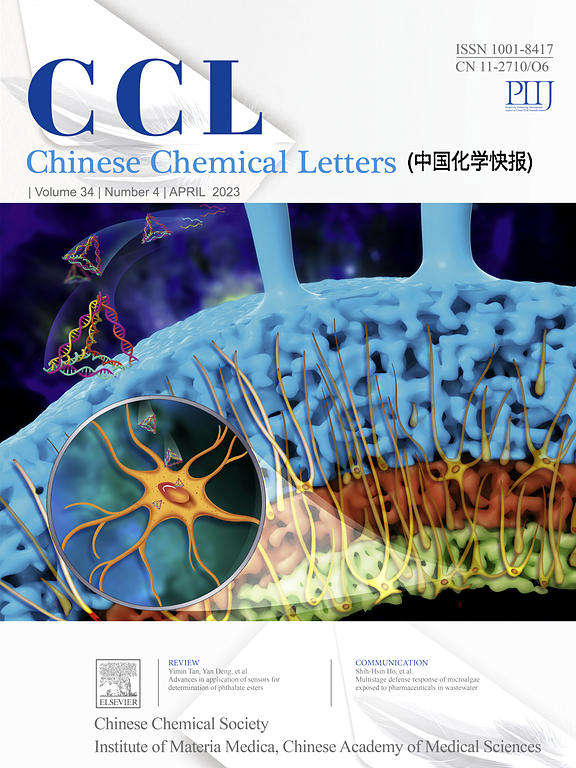调整FeNCN的有源面暴露以增强钠储存的假电容行为
IF 8.9
1区 化学
Q1 CHEMISTRY, MULTIDISCIPLINARY
引用次数: 0
摘要
碳二亚胺铁(FeNCN)阳极具有较高的反应活性和接近金属的导电性,具有快速储存钠离子的潜力。然而,FeNCN的进一步发展受到固有结构不稳定性和不明确的结构-动力学相关性的阻碍。在这项研究中,选择性暴露(002)和{010}的FeNCN晶体被精确地设计和合成。值得注意的是,FeNCN的钠储存动力学和电化学性能表现出多方面的变化。{010}晶面主导的多面体- fencn (P-FeNCN)表现出假电容驱动的存储机制,具有优异的倍率容量(5a /g时为372 mAh/g)和长循环能力(0.5 a /g下300次循环后容量保持率为95.8% %)。相比之下,片状FeNCN (S-FeNCN)的主要(002)面暴露由于离子扩散速率缓慢而表现出扩散受限的动力学。至关重要的是,时间分辨operando XRD分析和DFT模拟弥补了这一性能差距的机理根源:FeNCN作为插层转换型阳极,固态扩散是充放电过程中的速率决定步骤。活性{010}面具有大量宽六边形隧道,沿< 010 >方向具有0.168 eV的低扩散势垒。这种独特的结构配置使钠离子能够快速传输,从而将扩散控制的动力学转变为插层赝电容行为。这一发现建立了主动面暴露作为存储动力学开关,为优化钠离子电池的速率性能和稳定性提供了一个通用范例。本文章由计算机程序翻译,如有差异,请以英文原文为准。
Tailoring the exposure of active facets of FeNCN towards enhanced pseudocapacitive behavior for sodium storage
Iron carbodiimide (FeNCN) anode demonstrates significant potential for rapid sodium-ion storage owing to its high reaction activity and near-metallic conductivity. However, further development of FeNCN is hindered by inherent structural instability and ambiguous structure-kinetics correlation. In this study, FeNCN crystallites with selectively exposed (002) and {010} facets were precisely engineered and synthesized. Notably, the sodium storage kinetics and electrochemical performance of FeNCN exhibit facet-dependent variations. Polyhedral-FeNCN (P-FeNCN) dominated by {010} facets exhibited a pseudocapacitance-driven storage mechanism and delivered exceptional rate capability (372 mAh/g at 5 A/g) and long cyclability (95.8 % capacity retention after 300 cycles at 0.5 A/g). In contrast, sheet-like FeNCN (S-FeNCN) with predominant (002) facet exposure displayed diffusion-limited kinetics due to sluggish ion diffusion rate. Crucially, time-resolved operando XRD analysis and DFT simulation bridge this performance gap to mechanistic origins: FeNCN as an intercalation-conversion type anode, the solid-state diffusion is the rate-determining step during charge/discharge process. Active {010} facets possess numerous broad hexagonal tunnels, coupled with a low diffusion barrier of 0.168 eV along 〈010〉 directions. This unique architectural configuration enables rapid sodium-ion transport, thereby shifting the diffusion-controlled kinetics to intercalation-pseudocapacitive behavior. This discovery establishes active facet exposure as a storage kinetic switch, offering a generalized paradigm for optimizing the rate performance and stability of sodium-ion batteries.
求助全文
通过发布文献求助,成功后即可免费获取论文全文。
去求助
来源期刊

Chinese Chemical Letters
化学-化学综合
CiteScore
14.10
自引率
15.40%
发文量
8969
审稿时长
1.6 months
期刊介绍:
Chinese Chemical Letters (CCL) (ISSN 1001-8417) was founded in July 1990. The journal publishes preliminary accounts in the whole field of chemistry, including inorganic chemistry, organic chemistry, analytical chemistry, physical chemistry, polymer chemistry, applied chemistry, etc.Chinese Chemical Letters does not accept articles previously published or scheduled to be published. To verify originality, your article may be checked by the originality detection service CrossCheck.
 求助内容:
求助内容: 应助结果提醒方式:
应助结果提醒方式:


